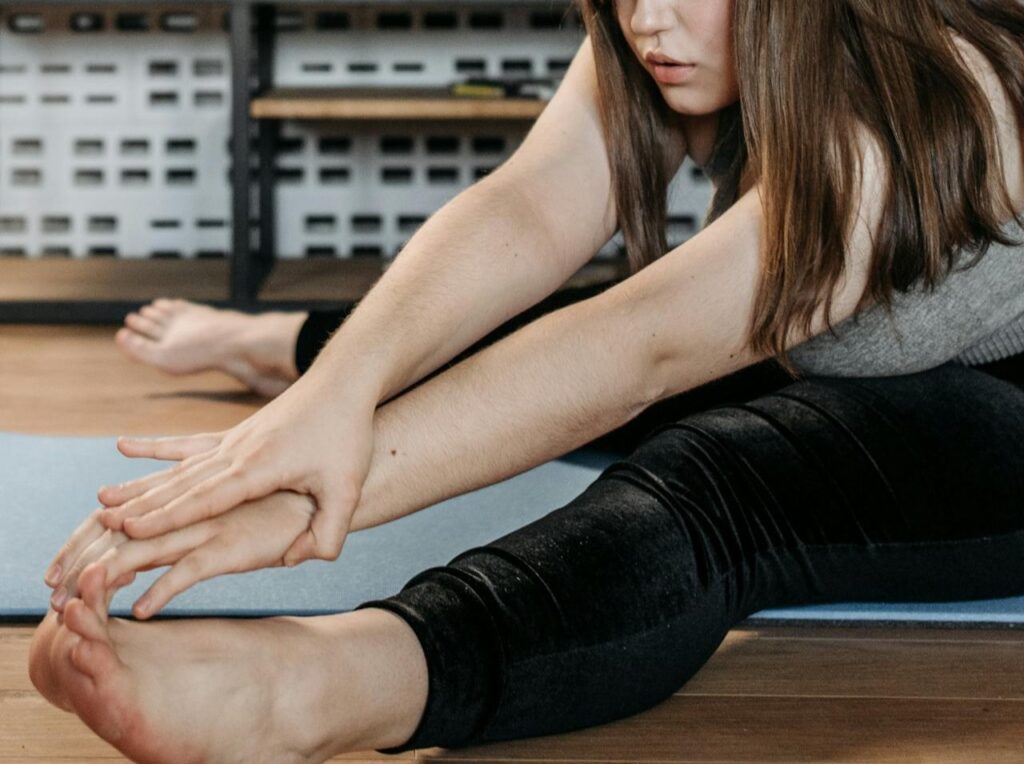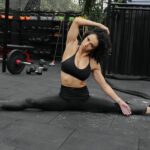Touching your toes might seem like a simple movement, but for many adults, it’s surprisingly challenging. Whether you’re sitting at a desk all day or haven’t stretched in years, tight hamstrings and limited flexibility can make this basic movement feel impossible. The good news? With the right approach, consistency, and proper techniques, anyone can improve their hamstring flexibility and work toward touching their toes.
This comprehensive guide will walk you through everything you need to know about improving your flexibility, from understanding why you can’t touch your toes to implementing a progressive stretching routine that delivers real results.
Why Can’t I Touch My Toes? Understanding the Barriers
Before diving into solutions, it’s important to understand what’s preventing you from touching your toes. The inability to perform this movement typically stems from several interconnected factors:
Tight Posterior Chain Muscles
The posterior chain includes your hamstrings, glutes, calves, and lower back muscles. When these muscles are tight, they create a pulling sensation that limits your forward bending range of motion. Your hamstrings, in particular, are often the primary culprit.
Sedentary Lifestyle Impact
Modern life has us sitting for extended periods, which shortens our hip flexors and tightens our hamstrings. When you sit for hours daily, your hamstrings remain in a shortened position, gradually losing their natural length and flexibility.
Anatomical Considerations
Some people face additional challenges due to their body proportions. Those with longer legs relative to their torso may find it more difficult to touch their toes, while excess body weight can also create physical barriers to forward bending.
Previous Injuries and Compensations
Past injuries to your lower back, hips, or legs can create compensatory movement patterns that limit flexibility. Your body may unconsciously restrict movement to protect previously injured areas.
The Science-Backed Benefits of Touching Your Toes
Improving your ability to touch your toes offers numerous benefits that extend far beyond the movement itself:
Enhanced Injury Prevention
Flexible hamstrings reduce your risk of muscle strains, lower back pain, and knee injuries. When your posterior chain moves freely, it takes pressure off other joints and muscles during daily activities and exercise.
Improved Posture and Spinal Health
Tight hamstrings can contribute to posterior pelvic tilt and lower back pain. By improving hamstring flexibility, you can help maintain proper spinal alignment and reduce chronic back discomfort.
Better Athletic Performance
Whether you’re running, jumping, or simply walking up stairs, flexible hamstrings contribute to more efficient movement patterns and improved performance in physical activities.
Enhanced Quality of Life
Simple daily tasks like picking up objects, tying your shoes, or getting out of bed become easier when you have adequate flexibility and range of motion.
Progressive Stretching Routine: 8 Essential Exercises
The key to successfully touching your toes lies in a progressive approach that gradually increases your flexibility over time. Here are eight proven exercises that target your hamstrings and supporting muscles:
1. Legs Up the Wall Stretch
This gentle, gravity-assisted stretch is perfect for beginners with very tight hamstrings.
How to perform:
- Lie on your back near a wall
- Scoot your glutes close to the wall and extend your legs up
- Keep your legs straight and feel the gentle stretch in your hamstrings
- Hold for 30-60 seconds, breathing deeply
2. Supine Hamstring Stretch with Strap
This controlled stretch allows you to adjust the intensity while maintaining proper form.
How to perform:
- Lie on your back with a towel or strap around one foot
- Keep the opposite leg flat on the ground
- Gently pull your leg toward your chest, keeping it straight
- Hold for 30 seconds, then switch legs
3. Seated Forward Fold with Support
Using a block or pillow under your sitting bones helps maintain proper pelvic positioning.
How to perform:
- Sit with legs extended, placing a block under your sitting bones
- Slowly hinge forward from your hips, not your lower back
- Reach toward your feet, focusing on lengthening your spine
- Hold for 30-45 seconds
4. Standing Forward Fold with Bent Knees
This variation reduces the intensity while still targeting your hamstrings effectively.
How to perform:
- Stand with feet hip-width apart
- Bend your knees slightly and fold forward from your hips
- Let your arms hang naturally toward the ground
- Gradually straighten your legs as your flexibility improves
5. Single-Leg Standing Stretch
This functional stretch mimics real-world movement patterns.
How to perform:
- Place one foot on a low step or curb
- Keep both legs straight and lean forward slightly
- Feel the stretch in the elevated leg’s hamstring
- Hold for 30 seconds, then switch legs
6. Cat-Cow Stretch for Spinal Mobility
While not directly targeting hamstrings, this movement improves spinal flexibility that supports forward bending.
How to perform:
- Start on hands and knees in a tabletop position
- Alternate between arching your back (cow) and rounding it (cat)
- Perform 10-15 slow, controlled movements
7. Active Straddle Stretch
This stretch targets your hamstrings while also improving hip flexibility.
How to perform:
- Sit with legs spread wide in a V-shape
- Place hands behind you for support
- Slowly walk your hands forward, maintaining a straight spine
- Hold for 30-45 seconds
8. Dynamic Leg Swings
These active movements help warm up your muscles and improve dynamic flexibility.
How to perform:
- Hold onto a wall or sturdy object for balance
- Swing one leg forward and backward in a controlled manner
- Perform 10-15 swings per leg
- Focus on gradually increasing your range of motion
Foam Rolling Techniques for Enhanced Flexibility
Foam rolling can significantly complement your stretching routine by releasing muscle tension and improving tissue quality:
Hamstring Foam Rolling
- Sit with the foam roller under your hamstrings
- Use your hands to support your weight and roll slowly
- Spend extra time on any tender spots
- Roll for 60-90 seconds per leg
Calf Foam Rolling
- Place the roller under your calves
- Cross one leg over the other for added pressure
- Roll from your ankle to just below your knee
- Focus on both the inner and outer portions of your calves
Lower Back Release
- Lie with the roller positioned at your lower back
- Keep your knees bent and feet flat on the ground
- Gently roll side to side, avoiding direct pressure on your spine
Advanced Strategies: Addressing the Gaps
Understanding Mobility vs. Flexibility
While flexibility refers to passive range of motion, mobility includes strength and control through that range. Incorporate exercises that challenge your hamstrings in their lengthened position to build both flexibility and strength.
Age-Related Adaptations
As we age, our muscles naturally lose some elasticity. If you’re over 40, be patient with your progress and consider holding stretches for longer periods (45-60 seconds) to achieve the same benefits as younger individuals.
Nutrition and Recovery Factors
Your diet and sleep quality significantly impact muscle recovery and flexibility. Ensure adequate protein intake for muscle repair, stay hydrated, and prioritize 7-9 hours of quality sleep to support your flexibility goals.
Breaking Through Plateaus
If your progress stalls, try varying your routine by:
- Increasing stretch duration
- Adding gentle resistance or partner-assisted stretching
- Incorporating heat therapy before stretching
- Trying different stretch variations
Creating Your Consistency Plan
Success in improving flexibility comes down to consistency rather than intensity. Here’s how to build a sustainable routine:
Frequency and Duration
- Aim for 3-4 stretching sessions per week minimum
- Each session should last 15-20 minutes
- Hold static stretches for 30-60 seconds
- Always warm up with 5-10 minutes of light movement
Tracking Your Progress
- Take photos or measurements weekly
- Note how close you can get to your toes
- Keep a flexibility journal to track improvements
- Celebrate small victories along the way
When to Seek Professional Help
Consider consulting a physical therapist or qualified trainer if you:
- Experience pain during stretching
- Have a history of lower back injuries
- See no improvement after 6-8 weeks of consistent practice
- Need help addressing specific movement limitations
Common Mistakes to Avoid
Forcing the Stretch
Never bounce or force your way into a stretch. This can cause injury and actually trigger your muscles to tighten further through the stretch reflex.
Neglecting Your Warm-Up
Cold muscles are more prone to injury. Always warm up with light movement before stretching.
Focusing Only on Hamstrings
Remember that touching your toes involves your entire posterior chain. Don’t neglect your calves, glutes, and lower back.
Inconsistent Practice
Sporadic stretching sessions won’t yield results. Consistency is far more important than intensity.
Your Path Forward: Taking Action Today
Improving your ability to touch your toes is a journey that requires patience, consistency, and the right approach. Start with the beginner-friendly exercises outlined in this guide, focus on proper form over intensity, and gradually progress as your flexibility improves.
Remember, everyone’s starting point is different, and progress may come slowly at first. The key is to stay consistent with your routine and trust the process. With dedicated practice, most people can see significant improvements in their hamstring flexibility within 4-8 weeks.
Begin today with just 10-15 minutes of gentle stretching, and you’ll be amazed at how much progress you can make over time. Your future self will thank you for taking this important step toward better flexibility and overall health.
Frequently Asked Questions
Q: How long does it take to touch your toes if you can’t currently do it?
A: With consistent practice (3-4 times per week), most people see significant improvement within 4-6 weeks. However, individual results vary based on starting flexibility, age, and consistency of practice.
Q: Is it normal to feel discomfort when stretching?
A: You should feel a gentle pulling sensation, but never sharp pain. Discomfort should be tolerable and should ease as you hold the stretch. If you experience pain, back off immediately.
Q: Can I stretch every day?
A: Yes, gentle stretching can be done daily. However, more intense stretching sessions should be limited to 3-4 times per week to allow for proper recovery.
Q: What if I have lower back pain when trying to touch my toes?
A: Lower back pain during forward bending often indicates tight hamstrings or improper technique. Focus on hinging from your hips rather than rounding your spine, and consider consulting a healthcare professional if pain persists.
Q: Are there any age limitations for improving flexibility?
A: Flexibility can be improved at any age, though progress may be slower for older adults. The key is starting gently and being patient with the process.



